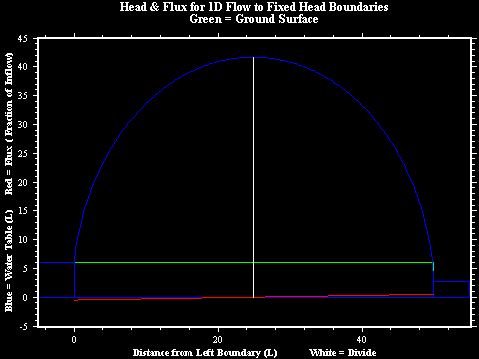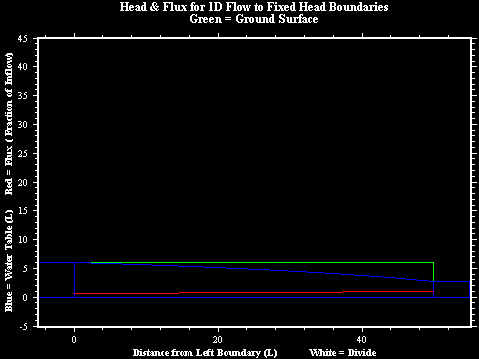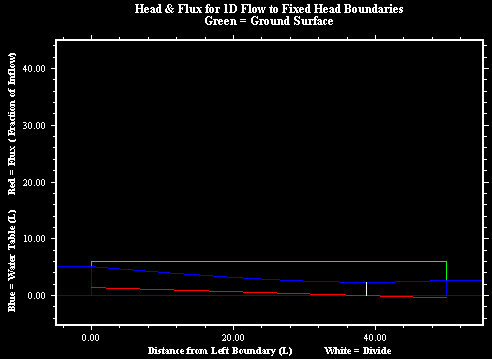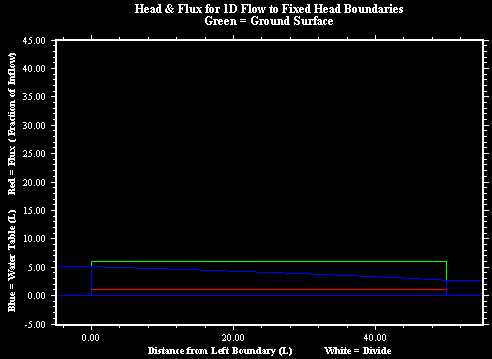EXPLORING ADDITION OF RECHARGE TO DUPUIT UNCONFINED FLOW
To calculate:
d
hmax
h12.5
h37.5
q to the river and
q to the canal
Given the base case:
- A river and canal parallel one another at a distance of 50 m
- Maximum ground surface elevation between them is 6 m
- Both fully penetrate a sand aquifer with K = 1x10-2 m/day
- Precipitation = 0.8 m/yr ET = 0.7 m/yr, so net recharge is 0.1 m/yr
- The river on the left is 5.1 m deep
- The canal on the right is 2.7 m deep
individually varying:
1. K = 1x10-4 m/day
2. K = 1x100 m/day
3. ET = 0.85 m/yr
4. W = 0 m/yr
1. for K = 1x10-4 m/day and all other parameters as in the base case:

| VARIABLE | CALCULATED VALUE | COMMENTS |
| d, divide | 24.9 m | The divide is close to the middle indicating that the recharge dominates flow through the system. |
| hmax | 41.6 m | The head is above surface elevation of 6 m! This is where the calibration process comes in. In a recharge area of an unconfined aquifer, we cannot have heads above the ground surface. Consequently we would conclude that we are incorrect either about the recharge rate or the hydraulic conductivity (after all the heads in the boundary features are easy to confirm in the filed) and we would adjust one or both the w and the K until the simulated heads match the heads observed in the field. |
| h12.5 | 36.1 m | Again, heads are above surface elevation of 6 m! |
| h37.5 | 36.0 m | Again heads are above the ground surface. Also note the head distribution is nearly symmetrical because the recharge flow is dominating the through flow. |
| qriver | -6.8 x
10-3 m3/day/m |
The negative value reflects flow in the negative x direction, which is flow out to the river. This is roughly half of the recharge. The recharge is 0.1 m/yr, or 2.73973 x 10-4 m/day, times the surface area of 50 m x 1 m, which is a total of 1.37 x 10-2 m3/day. |
| qcanal | +6.9 x
10-3 m3/day/m |
The positive value reflects flow in the positive x direction, or outflow to the canal. The the sum of the outflow to the canal and the river equals the recharge to the surface over the distance L which is (1.37 x 10-2 m3/day), thus MASS BALANCE IS ACCURATE. |
2. for K = 1x100 m/day and all other parameters as in the base case:

| VARIABLE | CALCULATED VALUE | COMMENTS |
| d, divide | -658 m | Outside problem domain - This reflects the distance to the left that would be needed to collect recharge at the rate W in order to equal the inflow from river. That is, it would take 658 m of land receiving recharge at W = 2.74 x 10-4m/day to yield an inflow of 0.1803 m2/day. You should check to see if there is enough water in the river discharge to provide this inflow for meter after meter of river length. |
| hmax | 120 m | This is the head that would occur at -658 m if material of K = 1x10-1 m/day extended that far. |
| h12.5 | 4.6 m | This is less than the boundary head which is consistent with inflow from the river. |
| h37.5 | 3.5 m | This value fall between those to the left and the right which is consistent with all flow in the system going from left to right. |
| qriver | +0.1803
m3/day/m |
This is substantially larger than the recharge to the system indicating that flow through from one fixed head boundary to the other dominates over inflow from recharge. |
| qcanal | +0.194
m3/day/m |
This is the sum of the inflow at the river and the recharge to the surface (1.37 x 10-2 m3/day), thus MASS BALANCE IS ACCURATE. |
3. for ET 0.85 m/yr, that is W = -0.05 = -1.37 x 10-4 m/day and all other parameters as in the base case:

| VARIABLE | CALCULATED VALUE | COMMENTS |
| d, divide | 38.7 m | This divide is asymmetric to the low head side of the land mass because the flow pattern is reversed. |
| hmax | 2.35 m | This head is lower than both boundary heads because the negative recharge (net evapotranspiration loss causes a concave water table surface). |
| h12.5 | 3.86 m | This is less than the boundary head which is consistent with inflow from the river and higher than the head at the divide which is consistent with net outflow to the surface. |
| h37.5 | 2.36 m | This is less than the boundary head which is consistent with inflow from the canal and higher than the head at the divide which is consistent with net outflow to the surface. |
| qriver | +5.3 x
10-3 m3/day/m |
The positive value reflects inflow from the river. The value is less than the total loss due to the negative recharge. |
| qcanal | -1.55 x
10-3 m3/day/m |
The negative
reflects inflow from the canal. When combined with inflow from the river
this balances the outflow (net loss to evapotranspiration is w * L, or 6.85
x 10-3 m3/day/m) from the surface over the distance L, thus MASS BALANCE IS ACCURATE. |
Remember to carry a number of significant figures for calculating and checking balances but round off for final reporting.
4. for W = 0 and all other parameters as in the base case:

| VARIABLE | CALCULATED VALUE | COMMENTS |
| d, divide | INFINITY | Given a recharge rate of zero, an infinite collection area would be required to the left of the model to satisfy the inflow from the river. |
| hmax | 5.1 m | The maximum head will occur at the left boundary and is fixed at 5.1 m. |
| h12.5 | 4.6 m | This is less than the boundary head which is consistent with inflow from the river and greater than the head at the canal which is consistent with flow from left to right through the aquifer. |
| h37.5 | 3.5 m | This is less than the river boundary head and greater than the canal boundary head which is consistent with flow from left to right in the system. |
| qriver | +1.87 x
10-3 m3/day/m |
The positive value reflects inflow from the river. |
| qcanal | +1.87 x
10-3 m3/day/m |
The positive value reflects outflow to the canal. It equals the inflow from the river because there is no additional recharge from the surface over the distance L. |
Notice that I illustrated all of the answers at the same scale even though some did not fill the entire graph. This is done so that a person can easily compare the different conditions. If the scale of the graph changes from figure to figure, it is difficult for the human mind to digest the differences. Keep this in mind presenting your own work.